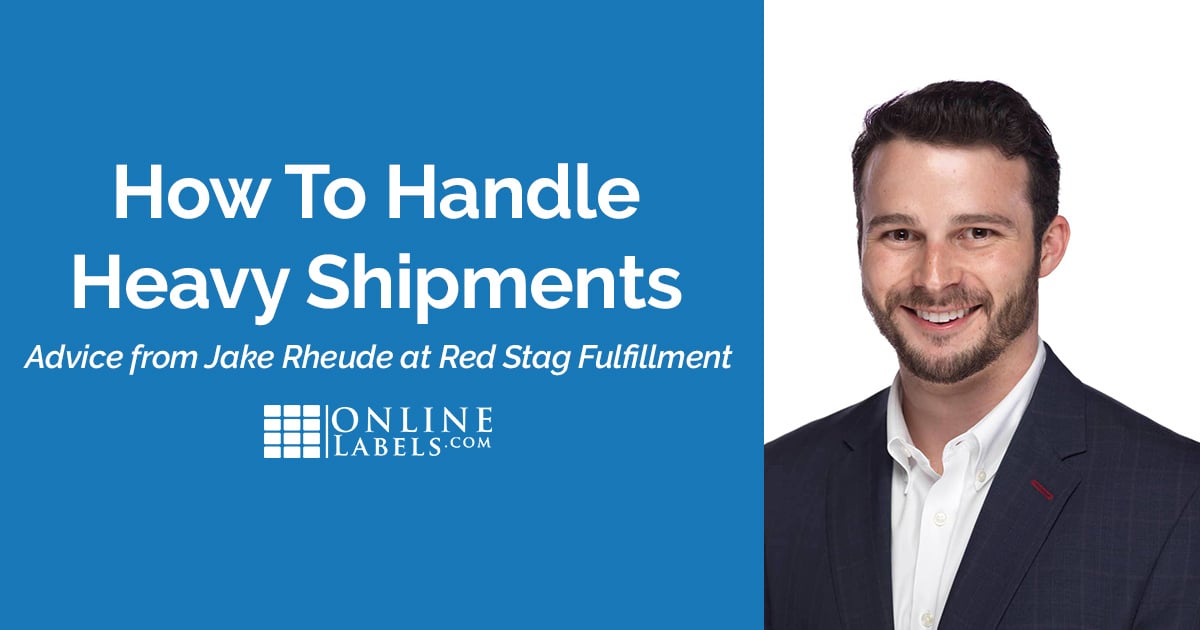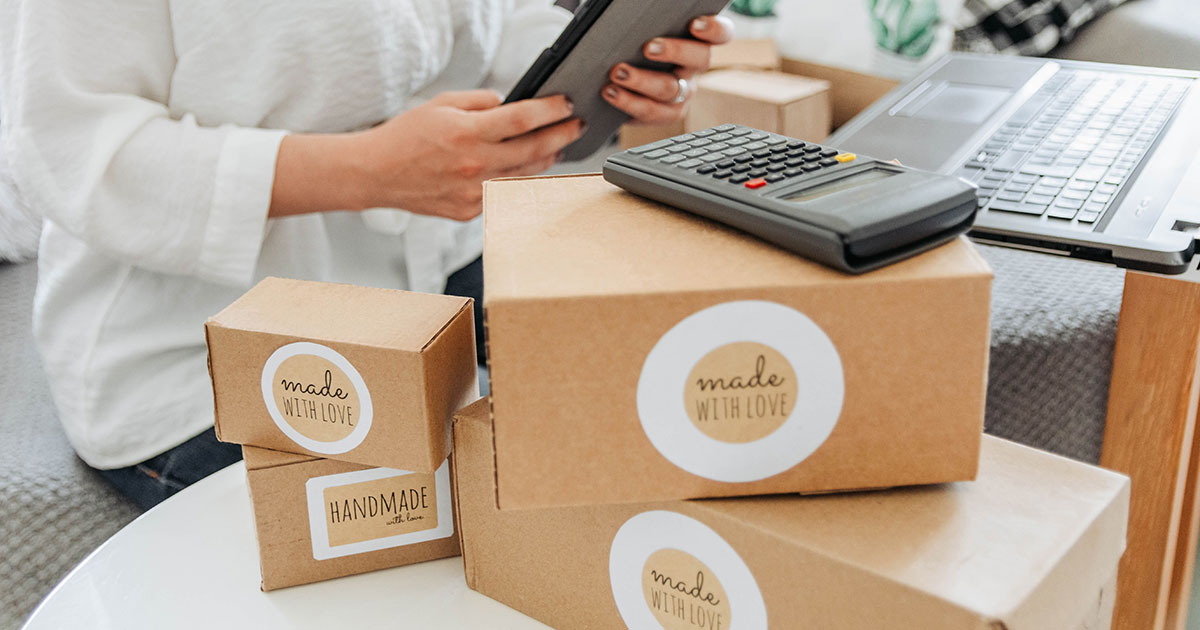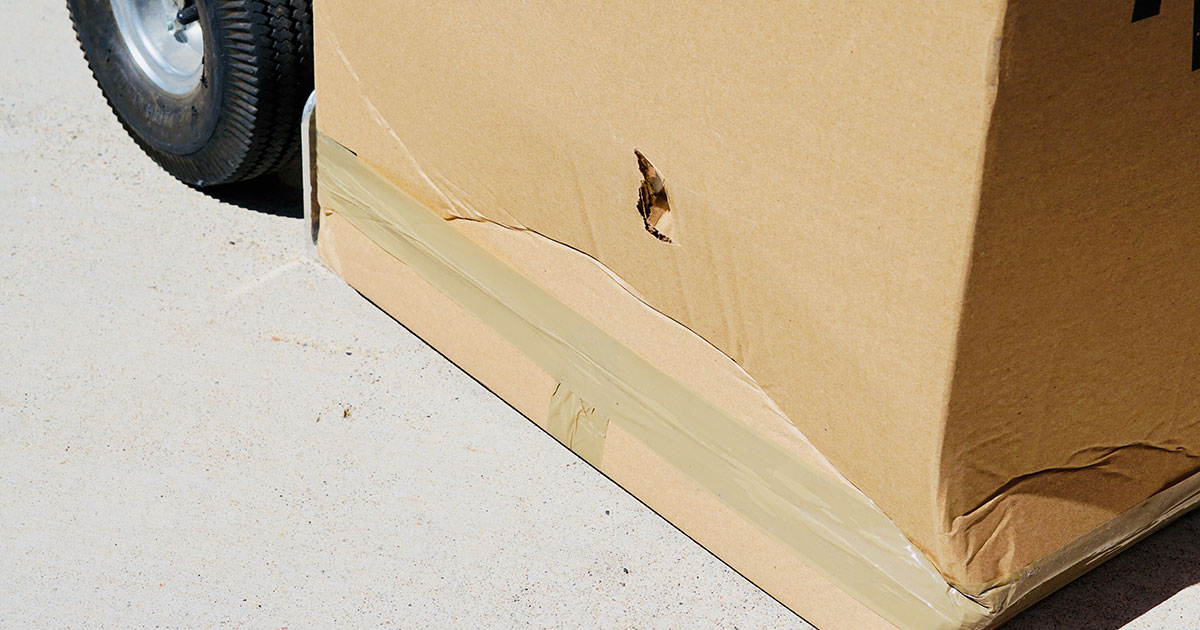How to Pack and Ship Heavy Items

Sometimes a "one-man band" entrepreneur simply has too many instruments to play. Between shipping orders, handling returns, providing customer service, and marketing, many small business owners turn to outsourcing to handle one or more of these jobs.
When it comes to outsourcing, fulfillment centers are often the first to be hired. That's because they serve a huge benefit to businesses by handling some of the most tedious aspects of the supply chain. This includes: product shipment, inventory, and returns. All of which are especially helpful when your products are large or heavy.
But when is using a fulfillment company actually worth it?
We talked with Jake Rheude, Vice President of Marketing at Red Stag Fulfillment – an order fulfillment company for online retailers and e-commerce businesses – to learn the pros and cons of using a third-party fulfillment company for large and/or heavy products vs. self-fulfilling.
What services can a fulfillment center provide?

A fulfillment center (or 3PL) mainly handles storing, packing, and shipping their customers' products. They can integrate their inventory tracking software to nearly any online platform, which is extremely convenient when it comes to managing inventory sold through Amazon, Shopify, Etsy, etc.
But, there's one service that's always more helpful than most businesses think.
"Returns handling is probably one of the biggest lifesavers a fulfillment center offers because returns are a huge headache," says Jake.
"Receiving and restocking a returned item saves a business a ton of time and is good value for money."
Additionally, most centers offer additional services like kitting – creating kits made up of multiple items in your inventory to sell for a set price – or assembling a product that comes shipped in different pieces. Red Stag Fulfillment, for example, offers video documented receiving, returns processing, hazardous materials handling, and a same-day fulfillment cutoff time of 5 p.m.
Moving Your Business Online
Fulfillment centers don't provide a physical place for customers to shop. Thus, if you're considering partnering with a fulfillment center, your business needs an online presence. And with an increasing amount of shopping being done online, establishing an e-commerce presence has never been a better idea.
If you're an artisan, selling online can expand your reach well beyond your immediate area, craft fairs, and farmers markets. Not to mention, you can make a sale any time of day.
"You can diversify your income by not only selling artisan products, but potentially using the audience you build up through social media to gain a commercial sponsor or two and create another income stream that way," says Jake.
There's no one-size-fits-all method for starting in e-commerce. You can sell products through popular marketplaces like eBay or Amazon, craft sites like Etsy, or through your own website. You can even sell through multiple online platforms in order to reach a larger group of consumers.
Of course, selling online does have its setbacks. While it's incredibly convenient for customers to shop in the comfort of their homes, there are several cons to consider if opting to move your business to the web.
'Try Before You Buy' Is Virtually Impossible
When shopping online, consumers lose the ability to touch and feel a product before purchasing it. If an online product description and its images are not incredibly detailed, you risk seeing an increase in returns, especially with large/heavy products or big-ticket items.
Not only can this hurt your reputation and product review scores over time, but cause a big dent in profits if you're having to cover return shipping costs.
See if product sampling makes sense for your business.
No In-Store Hospitality
Selling online also means losing person-to-person interactions with consumers. Whether you typically meet customers at farmers markets, craft fairs, pop-up shops, or brick-and-mortars, know that consumers miss out on the experience of discovering/shopping for your product if shopping online. And small business owners know that the person-to-person, in-store experience plays a huge role in first-time and repeated sales.
Shipping Fees Eat Into Profits
Shipping fees are an inevitable cost to doing business online. If your product is heavy or very large, shipping is likely going to be pricey.
How Fulfillment Centers Help
So when is it a good idea to consider the help of a fulfillment company?
1. You're spending too much time and money on shipping.

"If you're spending at least an hour per day fulfilling orders yourself, that's a lot of time that could be allocated toward marketing, product design, or other ways to grow your business," says Jake.
"And if you've hit at least 100 orders per month, you're probably spending so much on shipping that switching to a fulfillment center will save you money, since they get access to discounted shipping prices due to the high volume of packages they ship."
Most popular carriers like USPS®, FedEx®, and UPS® determine shipping costs based on shipping zones. What does this mean for you? If a large portion of your clientele lives beyond your shipping zone, costs can get more expensive (and that's on top of heavy or large item fees).
"If your business is based in Miami, Florida but you have many customers in the Midwest and on the West Coast, you're going to spend a lot of extra money on shipping to cover those extra zones," says Jake.
Of course, if you're working with a fulfillment center to send out your product, you'll receive lower rates.
2. Your order volume is increasing.
Fulfilling a large or heavy order can be more work than fulfilling smaller, lighter orders like t-shirts or jewelry. This is why volume is a big thing to consider, as not all items require the same amount of work.
There's no magic number, though, for how many units you need to sell in order to make hiring a fulfillment service worth it.
However, Jake says a general rule of thumb is to sell at least 100 units per month to make fulfillment worth it. That number could change if your average order size is very big or the average cost is very high.
In the end, it will depend on the amount of time you need to allocate to fulfilling orders, your budget, and the product itself. But if business is thriving and you find yourself spending valuable time on order fulfillment, this may be a sign that hiring a fulfillment company is worth considering.
3. Inventory space becomes an issue.
When storing large items becomes an issue, it may be time to let a fulfillment center take care of holding your products.
In addition, having a large amount of inventory under your control can create a path for mistakes, which costs money in the long run.
"If you send the wrong product to a customer or take too long to send the order out, you might end up having to issue an apology refund," says Jake.
"When you start noticing those mistakes happening more frequently, paying an expert company to handle inventory for you might be a good idea."
4. You plan to sell on Amazon.
According to CIRP, more than half of Amazon shoppers are Prime members. One of the biggest perks of Prime membership is free two-day delivery on eligible items. And with a whopping 105 million Amazon Prime members, you want to make sure your products are eligible.
"Your chances of success are much higher when you partner with a Seller Fulfilled Prime-certified company," says Jake.
"You can't be certified Prime if you self-fulfill out of your own garage, so you'll need to entrust your products to either Amazon itself (through Fulfillment by Amazon) or to a different fulfillment center, though not all are certified for Seller Fulfilled Prime."
Fees Associated With Shipping Large Or Heavy Items
While different fulfillment companies may have different charges/fee structures, the majority charge five main fees for their services:
- Set-up fees
- Receiving fees
- Storage fees
- Fulfillment fees
- Shipping fees
Also, keep in mind that large and/or heavy items may come with additional fees associated with storage, handling, and shipping. Below are some of the most common you may encounter:
Oversize Item Storage Costs
While fulfillment centers charge storage fees no matter the size-per-unit, storing larger items will typically cost more money per unit than if you stored standard sized items. Of course, this will depend on how much inventory you ship in as well.
"Companies assess storage fees differently; some charge by the square foot or meter, others charge by cubic foot or meter, while others charge by the pallet," says Jake.
"The most important variable is going to be the total volume your inventory takes up, not the size of individual units. It's up to you to do the math and figure out which type of pricing will be the best value for your business."
Overweight Handling Fees
Some fulfillment centers charge an extra fee for labor and/or handling of heavy items, but not all. Make sure to ask about this when you're comparing centers you're looking to potentially work with.
Monthly Order Volume Minimum Fees
Fulfillment centers have certain pick-and-pack rates, and some even advertise low rates (which is great if you're not selling a crazy amount of orders just yet).
For background, these rates are based on the predicted amount of orders per month. Monthly order volume minimum fees are charged if that predicted order volume is not met, so keep this in mind when figuring out which fulfillment center to work with.
Oversized Item Shipping Costs
Depending on how big the item actually is, you may run into having to cover additional costs for shipping (though this also applies whether you're using a fulfillment center or not). Most major carriers charge based on what's called dimensional weight – meaning how much space a package takes up in delivery vehicles.
Since oversized items naturally take up more space, these additional charges are inevitable.
Heavy items (even if not large) may also incur additional shipping fees.
"It's safer to assume that you will be charged more once your product hits a certain weight, depending on the company," says Jake.
"USPS, for example, charges for postage by the ounce; a fulfillment center may charge within a certain weight class."
Fees vary from company to company, so it's worth asking a sales rep what fees are assessed for each category before committing to any one fulfillment center.
When Self-Fulfilling Orders Is A Better Option
While using a fulfillment center has its benefits, there are reasons why you may want to continue fulfilling orders in-house.
Low order volumes – If you're only selling 20-30 units per month, hiring a fulfillment service may not be worth it yet, as costs can get too high.
Hyper-local clientele – If you prefer to only ship items within a certain area (either because the item is extremely fragile or too large/heavy), outsourcing fulfillment may not make sense.
Storage is not an issue – If you have a warehouse or space large enough to store surplus inventory, hiring a fulfillment center to store your inventory is not worth the money. If you need the additional help for fulfilling orders, you may be better off hiring personnel to work in your warehouse/space to assist with picking, packing, and shipping.
Tips For Self-Fulfilling Large Or Heavy Orders
If you decide to continue shipping your large and/or heavy orders for the time being, we've gathered a few tips to make it a little easier:
Choose Your Boxes Wisely

It's essential to use double-walled cardboard boxes when shipping heavy or valuable items. Saving money on single-walled, lightweight boxes will cost you more money in the long run if packages break and/or products are damaged due to flimsy box walls.
Insuring your shipments and doing everything you can to protect your inventory in transit should be a top priority. Making sure your orders arrive safely to the customer can help prevent product returns and unhappy customers.
Don't Size Up
"One of the most common mistakes made by owners doing self-fulfillment is using boxes that are too large for the item," says Jake.
"This is bad for two reasons: 1) The more snug the box is around the product, the more protected the product is; and 2) The cost of shipping goes up the bigger the package is."
Invest In A Paper-Cushioning Machine
Crinkling paper on your own, especially for large orders, can be both exhausting and time consuming. Consider purchasing a paper cushioning machine. These bad boys crinkle shipping paper in seconds.
Get The Good Tape
Simple, yet worth mentioning: use water-activated tape to secure boxes shut. Don't cheap out on this, trust us. The last thing you want is one of your packages ripping open from the bottom during transfer because the tape was too weak. Make sure to get the ones that are reinforced with fiber/strings for added durability, which are designed for packages weighing over 25 lbs.
Know Ways To Save On Shipping
There are certainly little know-hows to keep in mind to save on shipping costs yourself. Even if it's just a dollar here and a few cents there, the savings add up over time.
"FedEx, UPS, and USPS calculate shipping costs based on the amount of space a parcel takes up in their delivery vehicles, and charge accordingly," says Jake.
"As a general rule, you'll want to avoid using flat rate shipping for relatively lightweight objects, even if they're large like storage bins. Flat rate typically saves you money with heavier items."
Learn more about small business shipping.
Use Professional Shipping Labels
Not only does having sticker labels for shipping and tracking information look more professional, it saves you so much time in the long run.
To streamline your shipping process, OnlineLabels.com offers printable USPS® shipping labels, UPS® shipping labels, FedEx® shipping labels, and other sizes compatible with popular carriers. You can also find the size you need by shopping our selection of blank labels on rolls or fanfold labels.
Also be sure to check out our selection of pre-printed shipping warning labels.
Find more useful business and labeling articles to help your business grow.



